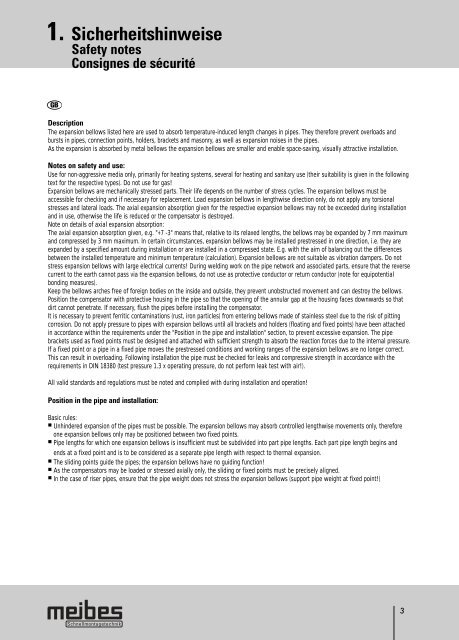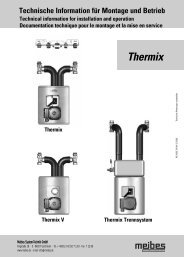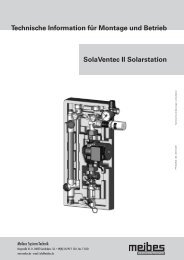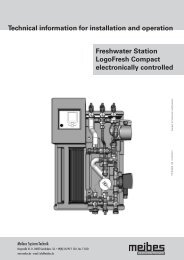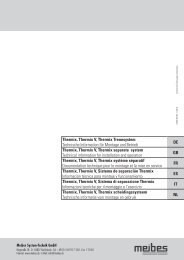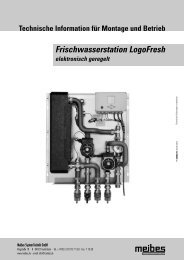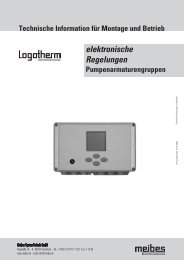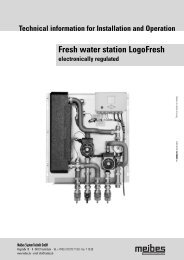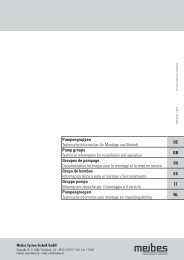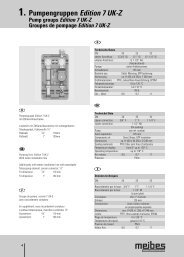Dehnungsausgleicher Technische Information für Montage ... - Meibes
Dehnungsausgleicher Technische Information für Montage ... - Meibes
Dehnungsausgleicher Technische Information für Montage ... - Meibes
You also want an ePaper? Increase the reach of your titles
YUMPU automatically turns print PDFs into web optimized ePapers that Google loves.
1. Sicherheitshinweise<br />
Safety notes<br />
Consignes de sécurité<br />
GB<br />
Description<br />
The expansion bellows listed here are used to absorb temperature-induced length changes in pipes. They therefore prevent overloads and<br />
bursts in pipes, connection points, holders, brackets and masonry, as well as expansion noises in the pipes.<br />
As the expansion is absorbed by metal bellows the expansion bellows are smaller and enable space-saving, visually attractive installation.<br />
Notes on safety and use:<br />
Use for non-aggressive media only, primarily for heating systems, several for heating and sanitary use (their suitability is given in the following<br />
text for the respective types). Do not use for gas!<br />
Expansion bellows are mechanically stressed parts. Their life depends on the number of stress cycles. The expansion bellows must be<br />
accessible for checking and if necessary for replacement. Load expansion bellows in lengthwise direction only, do not apply any torsional<br />
stresses and lateral loads. The axial expansion absorption given for the respective expansion bellows may not be exceeded during installation<br />
and in use, otherwise the life is reduced or the compensator is destroyed.<br />
Note on details of axial expansion absorption:<br />
The axial expansion absorption given, e.g. "+7 -3" means that, relative to its relaxed lengths, the bellows may be expanded by 7 mm maximum<br />
and compressed by 3 mm maximum. In certain circumstances, expansion bellows may be installed prestressed in one direction, i.e. they are<br />
expanded by a specified amount during installation or are installed in a compressed state. E.g. with the aim of balancing out the differences<br />
between the installed temperature and minimum temperature (calculation). Expansion bellows are not suitable as vibration dampers. Do not<br />
stress expansion bellows with large electrical currents! During welding work on the pipe network and associated parts, ensure that the reverse<br />
current to the earth cannot pass via the expansion bellows, do not use as protective conductor or return conductor (note for equipotential<br />
bonding measures).<br />
Keep the bellows arches free of foreign bodies on the inside and outside, they prevent unobstructed movement and can destroy the bellows.<br />
Position the compensator with protective housing in the pipe so that the opening of the annular gap at the housing faces downwards so that<br />
dirt cannot penetrate. If necessary, flush the pipes before installing the compensator.<br />
It is necessary to prevent ferritic contaminations (rust, iron particles) from entering bellows made of stainless steel due to the risk of pitting<br />
corrosion. Do not apply pressure to pipes with expansion bellows until all brackets and holders (floating and fixed points) have been attached<br />
in accordance within the requirements under the "Position in the pipe and installation" section, to prevent excessive expansion. The pipe<br />
brackets used as fixed points must be designed and attached with sufficient strength to absorb the reaction forces due to the internal pressure.<br />
If a fixed point or a pipe in a fixed pipe moves the prestressed conditions and working ranges of the expansion bellows are no longer correct.<br />
This can result in overloading. Following installation the pipe must be checked for leaks and compressive strength in accordance with the<br />
requirements in DIN 18380 (test pressure 1.3 x operating pressure, do not perform leak test with air!).<br />
All valid standards and regulations must be noted and complied with during installation and operation!<br />
Position in the pipe and installation:<br />
Basic rules:<br />
� Unhindered expansion of the pipes must be possible. The expansion bellows may absorb controlled lengthwise movements only, therefore<br />
one expansion bellows only may be positioned between two fixed points.<br />
� Pipe lengths for which one expansion bellows is insufficient must be subdivided into part pipe lengths. Each part pipe length begins and<br />
ends at a fixed point and is to be considered as a separate pipe length with respect to thermal expansion.<br />
� The sliding points guide the pipes; the expansion bellows have no guiding function!<br />
� As the compensators may be loaded or stressed axially only, the sliding or fixed points must be precisely aligned.<br />
� In the case of riser pipes, ensure that the pipe weight does not stress the expansion bellows (support pipe weight at fixed point!)<br />
3


